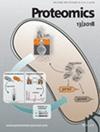致瘤性H-Ras重编程Madin-Darby犬肾(MDCK)细胞来源的中间残体蛋白质组在上皮-间质转化后。
摘要
上皮-间质转化(EMT)是一个基本的、动态的细胞过程,涉及胚胎发育、转移、器官纤维化和组织再生。为了确定EMT过程中分泌的中体残留物(MBRs)的分子景观,对Madin-Darby犬肾(MDCK)细胞和致癌H-Ras转化后(21D1细胞)释放的MBRs进行了蛋白质组学分析。mbr是一类分子上不同于外泌体/小外泌体的膜性细胞外囊泡(EV),采用顺序离心/浮力密度梯度离心纯化。蛋白质组学分析显示MDCK细胞mbr反映了它们的上皮来源(例如,富集的CDH1、DSP、THBS1、OLCN、EPCAM蛋白),而21D1细胞mbr反映了它们的致癌和间质表型(例如,HRAS、VIM、MMP14、CDH2、WNT5A,以及富集的侵袭性和细胞运动蛋白网络)。蛋白质组货物的验证揭示了MBR中与EMT过程相关的关键蛋白质网络,以及不同细胞类型中保守的MBR蛋白质组。突出的发现是免疫检查点蛋白NT5E/CD73(外5′-核苷酸酶)和丝氨酸/丝氨酸激酶LIMK1/K2在间充质细胞的mbr中致癌转化后的独特表达,以及Wnt信号网络蛋白的富集。这些数据确定了在EMT动态过程中调控的mbr的核心蛋白质组,以及在EMT过程中对其他EV类型的细胞转化。上皮-间充质转化(Epithelial-to-mesenchymal transition, EMT)是发生在胚胎发育和癌症进展过程中的一个关键细胞生物学过程。我们的研究描述了从体外细胞系EMT模型Madin-Darby犬肾(MDCK)细胞和经致癌H-Ras转化的MDCK细胞(21D1细胞)中连续纯化分泌的中间体残留物(mbr)和外泌体/ sev:蛋白质组学鉴定了EMT后富集的MDCK- mbr蛋白库。mbr显示出与sev不同的蛋白质组谱,其富含中央纺锤蛋白复合物(KIF23.1, KIF4A, INCENP, CEP55, PLK1)的因子,并进一步包括线粒体网络,细胞分裂,微管运动和细胞间连接的成分。在EMT的背景下,我们的数据揭示了mbr中丰富的EMT通路,包括信号受体结合、细胞分化调节以及Wnt、VEGF和PDGF信号传导。我们已经在其他EV类型的Wnt信号的背景下验证了这些发现。我们在MBRs中发现了几个与局灶黏附、细胞基质、激酶活性和细胞形状/组织相关的间充质富集网络,而上皮来源的MBRs则显示了主要与线粒体(加工/运输)、中间体和质膜注释相关的富集网络。我们的研究揭示了h - ras诱导的EMT在细胞转化过程中致癌mbr的蛋白质组结构:总的来说,我们的数据为正在进行的描述癌症起始、进展和转移的致癌驱动因素的工作提供了信息。Epithelial-mesenchymal transition (EMT) is a fundamental, dynamic cellular process involved in embryonic development, metastasis, organ fibrosis, and tissue regeneration. To define the molecular landscape of secreted midbody remnants (MBRs) to the EMT process, a proteome analysis of MBRs released from Madin-Darby canine kidney (MDCK) cells and following oncogenic H-Ras transformation (21D1 cells) was performed. MBRs, a new class of membranous extracellular vesicle (EV) molecularly distinct from exosomes/small EVs, were purified using sequential centrifugation/buoyant density gradient centrifugation. Proteomic profiling revealed MDCK cell-MBRs reflect their epithelial origin (e.g., enriched CDH1, DSP, THBS1, OLCN, EPCAM proteins) and 21D1 cell-MBRs their oncogenic and mesenchymal phenotype (e.g., HRAS, VIM, MMP14, CDH2, WNT5A, and enriched invasive and cell motility protein networks). Validation of proteome cargo revealed key protein networks associated with the EMT process in MBRs, and conserved MBR proteome across different cell types. Prominent findings were the unique expression of the immune checkpoint protein NT5E/CD73 (ecto-5'-nucleotidase) and ser/thr kinases LIMK1/K2 in MBRs from mesenchymal cells following their oncogenic transformation, and enrichment in Wnt signaling network proteins. These data identify the core proteome of MBRs regulated during the dynamic process of EMT and cell transformation over other EV types in context of the EMT process. SUMMARY: Epithelial-to-mesenchymal transition (EMT) is a critical cell biological process that occurs during embryonic development and cancer progression. Our study describes sequential purification of secreted midbody remnants (MBRs) and exosomes/sEVs from the in vitro cell line EMT model Madin-Darby canine kidney (MDCK) cells and MDCK cells transformed with oncogenic H-Ras (21D1 cells): Proteomics identified the repertoire of enriched MDCK-MBR proteins following EMT. MBRs display a proteome profile distinct from sEVs that is enriched with factors of the centralspindlin complex (KIF23.1, KIF4A, INCENP, CEP55, PLK1) and further includes components of the mitochondrial network, cytokinesis, microtubule movement, and intercellular connection. In the context of EMT, our data reveal enriched EMT pathways in MBRs including signaling receptor binding, regulation of cell differentiation, and Wnt, VEGF, and PDGF signaling. We have validated these findings in the context of Wnt signaling in other EV types. We identify several mesenchymal-enriched networks in MBRs associated with focal adhesion, cell matrix, kinase activity, and cell shape/organization, while epithelial-derived MBRs show enriched networks predominantly associated with mitochondrial (processing/transport), midbody, and plasma membrane annotation. Our study sheds light on the proteome architecture of MBRs following oncogenic H-Ras-induced EMT in cell transformation: collectively, our data informs ongoing efforts to delineate oncogenic drivers of cancer initiation, progression, and metastasis.

 求助内容:
求助内容: 应助结果提醒方式:
应助结果提醒方式:


